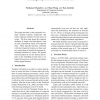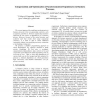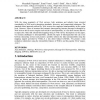958 search results - page 117 / 192 » Using the UML for Architectural Description |
ACL
2007
13 years 10 months ago
2007
This paper describes a fully automatic twostage machine learning architecture that learns temporal relations between pairs of events. The first stage learns the temporal attribut...
ICDE
2007
IEEE
14 years 10 months ago
2007
IEEE
requirement. Furthermore, programming using sequence constructs normally produce nested structures and The current approachfor modeling synchronization in scattered code, especiall...
JWSR
2007
13 years 8 months ago
2007
: With the rising popularity of Web services, both academia and industry have invested considerably in Web service description standards, discovery, and composition techniques. The...
CL
2008
Springer
13 years 9 months ago
2008
Springer
Currently available application frameworks that target the automatic design of real-time embedded software are poor in integrating functional and non-functional requirements for m...
IEEESCC
2007
IEEE
14 years 3 months ago
2007
IEEE
UN/CEFACT’s Modeling Methodology (UMM) is a UML profile for modeling global B2B choreographies. The basic building blocks of UMM are business transactions, which describe the e...



